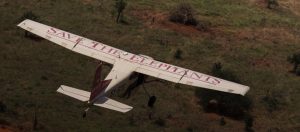
Counting a third of Kenya’s elephants in one operation is no small challenge, especially in the vast, trackless expanse of Tsavo, Kenya’s largest protected area. The 48,000 square kilometres must be accurately covered in as short a time as possible to minimise counting errors induced by animal movements, so the Kenya Wildlife Service (KWS) marshalled together a team of no fewer than 16 aircraft and 130 people for the operation.
KWS performs this feat every three years, but this was my first Tsavo census in the Save the Elephants Cessna 185. After two days of crew training and calibration (it is important to gauge the relative ability of crews to count animals), the count began in earnest on the misty morning of 5th February 2014.
16 aircraft, mostly bush-flying tail-draggers, came together for the count. The majority were volunteer pilots experienced in conservation flying.
Tsavo’s Natural Wonders
Tsavo’s wonderful diversity of landscapes are best viewed from 300 feet above the ground in early morning light: the towering Taita Hills, the wide, arid plains with the great green river systems snaking through them, and the majestic cliffs of the Ngulia hills with elephant herds high on the hillsides.
At the southern end of Tsavo the park crosses the border with Tanzania and becomes the Mkomazi National Park. Counting these blocks showed remarkable differences between the two. While on the Kenyan side of the border we recorded hundreds upon hundreds of charcoal kilns within the National Park, with well-established camps and lorries for transport together with large herds of livestock, in Tanzania we recorded almost no livestock and only three kilns (and these only metres over the border).
With data flooding in from across the continent documenting catastrophic declines in elephant populations, we flew with bated breath. Across the border in the Selous, a census in October 2013 found that the elephant population had plummeted by 67 per cent in just four years. Of the estimated 109,000 that STE’s founder Iain Douglas-Hamilton counted in 1976, only around 13,000 remain.
Babies beneath every elephant
As we flew our exact 1-kilometre transects to cover more than 700 square kilometres a day, we counted all the elephants and Grevy zebras that we saw along with as many of the other large species that we could record. At the last census in 2011, an estimated 12,500 elephants were counted in the Tsavo area.
This time, we were heartened to see that every herd was far more plentiful than we first thought. On sighting a group we’d wheel around to get a closer look and often a scurry of tiny shapes would suddenly emerge from beneath the bulk of their mothers. The place seemed full of baby elephants. When the group was made up of bulls the sight was no less uplifting, and many times we saw animals sporting magnificent ivory. These are the elephants that the Tsavo Trust, STE’s partners in the ecosystem, are working so hard to protect.
On the day after the counting finished, KWS announced a provisional figure of an estimated 11,000 elephants in Tsavo, 1,500 down from three years before. As we wait for the final results of the total count, a team from Elephants Without Borders have begun a sample count – a complimentary technique that will provide a deep and valuable comparison. Theirs is the first operation in the massive 2nd Pan-African Aerial Elephant Census, led by Dr. Mike Chase and funded by the Microsoft billionaire Paul Allen.
The Tsavo total count was orchestrated by the Kenya Wildlife Service and received significant support from the International Fund for Animal Welfare, The David Sheldrick Wildlife Trust and CITES.

